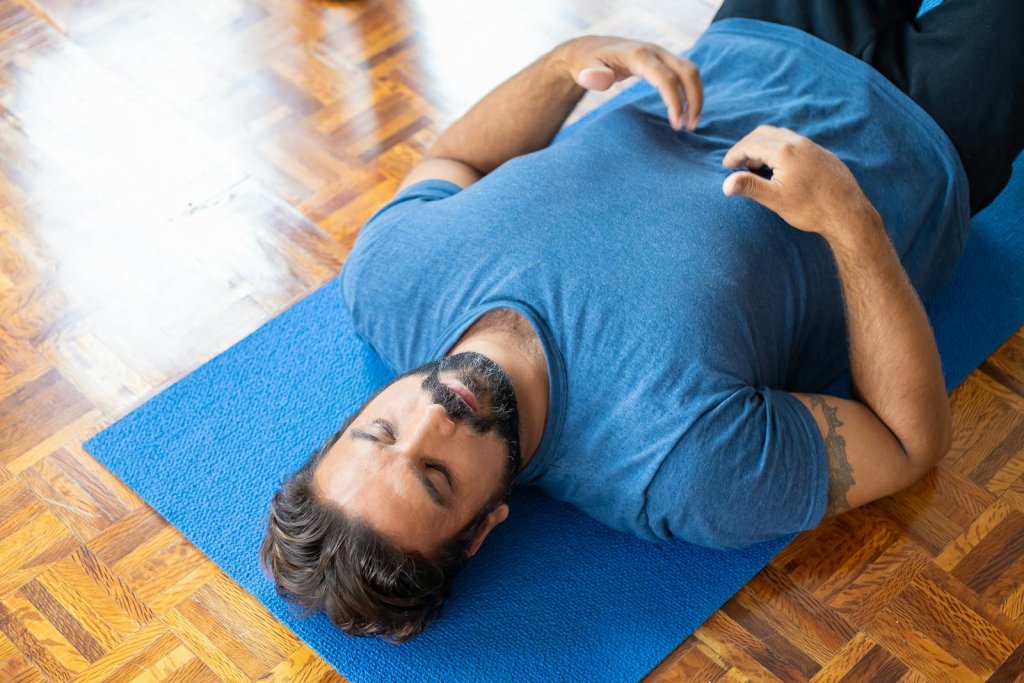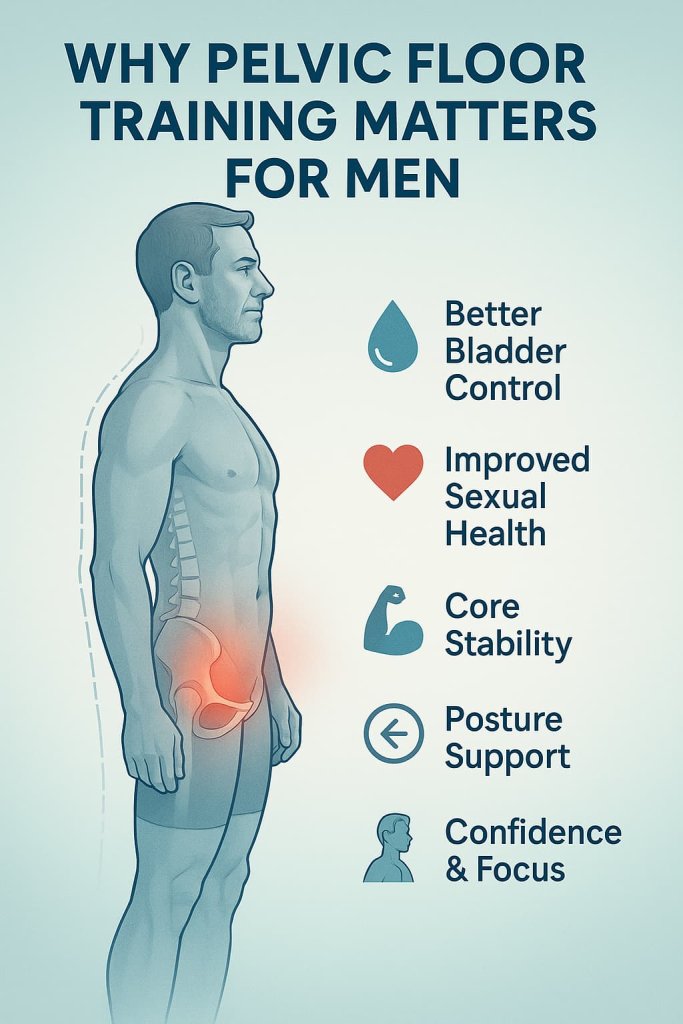Pelvic floor exercises for men improve bladder control, sexual function, and core strength — naturally and effectively.
These simple yet powerful movements target the deep muscles that support your bladder, bowel, and sexual organs. Strengthening them helps prevent leaks, boosts performance, and stabilizes your posture.

Understanding and training these muscles is essential, especially for men facing issues like post-prostate surgery incontinence, premature ejaculation, or weak core stability.
In this guide, you’ll learn the 10 best pelvic floor exercises for men, how to perform them correctly, and how they support confidence, control, and long-term health.
Why Pelvic Floor Training Matters for Men
Pelvic floor training strengthens the deep muscles that control bladder, bowel, and sexual function — key for confidence and overall health.
Evidence in men shows that performing pelvic floor muscle training several times per week for 8–12 weeks improves urinary control, with clinically meaningful reductions in leakage; exact percentages vary by study design and population. PFMT is also supported for post-prostate treatment recovery and may improve erectile function, while contributing to core/postural stability.

It also improves erection quality, posture, and core stability while preventing age-related weakness.
Benefits of Pelvic Floor Exercises for Men
- Better Bladder Control: Reduces leaks and post-urination dribbling.
- Improved Sexual Health: Supports stronger erections and delayed ejaculation.
- Enhanced Core Strength: Builds internal stability for daily movements.
- Post-Surgery Recovery: Aids in faster rehabilitation after prostate surgery.
- Better Posture & Balance: Supports spine alignment and pelvic stability.
How to Activate Your Pelvic Floor Muscles

Before you start any exercise, identify the correct muscles:
- While urinating, try stopping the flow mid-stream (do this once only).
- Feel the internal lift — that’s your pelvic floor.
- Avoid squeezing your abs, glutes, or thighs.
- Once identified, contract and lift these muscles while breathing normally.
Precision matters more than force. A correct contraction should feel like an inward and upward lift.
10 Best Pelvic Floor Exercises for Men
These science-backed moves strengthen the deep muscles that control your bladder, posture, and performance.
Practice them consistently to build core stability, improve confidence, and support long-term pelvic health.
1. Kegel Contractions
Why it works:
The foundational move for men’s pelvic health. Kegels directly target and strengthen the pelvic floor muscles that control urination, ejaculation, and core stability. Research shows consistent Kegel training improves bladder control and erectile function in as little as 8 weeks (BMC Urology, 2024).
Muscles worked:
Pelvic floor (levator ani, coccygeus), deep core stabilizers.
How to do it:
- Sit or lie down comfortably with your spine neutral.
- Contract your pelvic floor muscles as if trying to stop the flow of urine.
- Hold for 3–5 seconds, then relax for 5.
- Repeat 10–15 times, three times daily.
Trainer Tip:
Avoid squeezing your abs or glutes—focus on a gentle inward lift. Progressively increase your hold time to 10 seconds as control improves.
2. Bridge Pose
Why it works:
Combines glute activation with pelvic floor engagement, building full-hip and core stability. The upward hip drive mirrors the natural “lift” of the pelvic floor.
Muscles worked:
Gluteus maximus, hamstrings, pelvic floor, lower back.
How to do it:
- Lie on your back, knees bent, feet hip-width apart.
- Engage your pelvic floor, then lift hips off the floor until shoulders, hips, and knees align.
- Hold 5 seconds, then lower slowly.
- Perform 10–12 reps.
Trainer Tip:
Keep breathing—exhale as you lift, inhale as you lower. Don’t arch your lower back.
3. Squats
Why it works:
Squats recruit large leg muscles and engage deep pelvic stabilizers, teaching the pelvic floor to activate during real-world movement.
Muscles worked:
Quadriceps, glutes, pelvic floor, core stabilizers.
How to do it:
- Stand with feet shoulder-width apart.
- Inhale, hinge hips back, and lower into a squat.
- As you exhale to stand, contract your pelvic floor.
- Perform 12–15 reps.
Trainer Tip:
Move slowly with control—avoid bouncing or locking knees at the top.
4. Bird Dog
Why it works:
Integrates pelvic floor control with spinal stability, improving balance and core endurance.
Muscles worked:
Pelvic floor, erector spinae, glutes, abdominals, shoulders.
How to do it:
- Start on hands and knees.
- Engage pelvic floor and core.
- Extend your right arm and left leg simultaneously.
- Hold 3 seconds, return, and switch sides.
- Do 10 reps per side.
Trainer Tip:
Keep hips square and spine neutral—imagine balancing a glass of water on your back.
5. Pelvic Tilts
Why it works:
Enhances coordination between lower abs and pelvic floor, helping you learn controlled contractions without strain.
Muscles worked:
Pelvic floor, rectus abdominis, lower back.
How to do it:
- Lie on your back, knees bent, feet flat.
- Flatten your lower back against the floor by tightening your core and pelvic floor together.
- Hold 3 seconds, then relax.
- Repeat 12–15 times.
Trainer Tip:
Great warm-up for beginners—focus on smooth motion and relaxed breathing.
6. Standing Kegels
Why it works:
Teaches the pelvic floor to activate under gravity and daily posture—essential for functional control.
Muscles worked:
Pelvic floor, deep core stabilizers, postural muscles.
How to do it:
- Stand tall with relaxed shoulders.
- Contract pelvic floor for 5 seconds, release for 5.
- Repeat 10–15 times, two to three times daily.
Trainer Tip:
Perfect for multitasking—practice during showering, brushing teeth, or commuting.
7. Wall Sits
Why it works:
Engages quadriceps and pelvic floor for endurance and stability, simulating real-world tension control.
Muscles worked:
Quadriceps, glutes, pelvic floor, abdominals.
How to do it:
- Stand with back against wall, feet 2 feet forward.
- Slide down until knees form 90°.
- Engage pelvic floor and hold 20–30 seconds.
- Rest 30 seconds; repeat 3–4 sets.
Trainer Tip:
Focus on slow exhalation and steady pelvic contraction throughout the hold.
8. Dead Bug
Why it works:
Builds coordination between pelvic floor and deep core stabilizers—ideal for improving balance and control.
Muscles worked:
Pelvic floor, transverse abdominis, hip flexors, shoulders.
How to do it:
- Lie on your back with arms extended and knees bent 90°.
- Engage core and pelvic floor.
- Lower opposite arm and leg slowly until hovering above floor.
- Return and switch sides for 10–12 reps per side.
Trainer Tip:
Keep your lower back pressed to the mat to prevent strain.
9. Seated March
Why it works:
A safe, low-impact option for beginners and older men that trains coordination and activation while seated.
Muscles worked:
Pelvic floor, hip flexors, abdominals.
How to do it:
- Sit tall on a sturdy chair, hands on thighs.
- Engage pelvic floor and lift one knee toward chest.
- Lower slowly and alternate legs for 20 reps total.
Trainer Tip:
Keep your torso still—avoid leaning back or using momentum.
10. Glute Squeeze
Why it works:
Encourages synergy between glutes and pelvic floor for better pelvic stability and posture.
Muscles worked:
Gluteus maximus, pelvic floor, lower back.
How to do it:
- Sit or stand tall.
- Squeeze both glutes for 5 seconds, release 5.
- Repeat 15–20 times.
Trainer Tip:
Exhale as you contract to enhance pelvic activation; keep shoulders relaxed.
Related:
Safety and Precautions
- Avoid excessive straining — focus on gentle contractions.
- Don’t hold your breath; exhale naturally during effort.
- Empty your bladder before exercises.
- If you experience pain or pelvic tightness, stop and consult a physiotherapist.
- For post-prostate surgery recovery, always follow medical guidance.
How Often Should You Train?
For best results:
- Frequency: 3–5 days per week
- Duration: 10–15 minutes per session
- Progress: Expect visible improvements within 8–12 weeks
A 2011 Journal of Strength & Conditioning Research study found that consistent PFMT, done three times weekly, improved male pelvic-floor strength by 45% within two months.
Who Should Do Pelvic Floor Exercises
These exercises benefit nearly all men, especially those who:
- Are recovering from prostate surgery
- Experience urinary leaks or post-void dribbling
- Have erectile or ejaculatory issues
- Sit for long hours or are over 40
- Want better core strength and lifting control
Tip: Men with pelvic pain or recent surgery should seek guidance from a pelvic-health physiotherapist before starting.
Common Mistakes
- Contracting abs or buttocks instead of pelvic floor
- Holding breath
- Over-tensing (causing fatigue)
- Inconsistent routine
Correct form + regularity = lasting control and confidence.
FAQ
1. Can men really do Kegels?
Yes. Kegels are equally effective for men and women when done correctly.
2. How long until results appear?
Most men notice improved control in 6–12 weeks with regular training.
3. Are pelvic floor exercises safe after prostate surgery?
Yes — in fact, they are a recommended recovery tool under medical supervision.
4. Can these exercises help with erectile function?
Yes. Studies show stronger pelvic floor muscles improve erectile rigidity and delay ejaculation.
5. Should I see a physiotherapist?
Yes, if you’re unsure about muscle activation or have pelvic pain. Specialized physiotherapists can guide you.
6. Can I do these at work or while standing?
Absolutely. Many men practice standing Kegels discreetly during daily activities.
7. Do they replace core workouts?
No, but they complement them — enhancing overall stability and control.
Conclusion
Pelvic floor exercises for men aren’t just about bladder control — they build strength, confidence, and performance from the inside out.
By practicing these 10 movements regularly, you’ll improve control, posture, and energy — all vital for long-term male health.
Start today — consistency pays off in weeks, not years.
This content is for informational purposes only and not medical advice.
References
- AUA/GURS/SUFU Guideline (Amended 2024) — Incontinence after prostate treatment
Recommends pelvic floor muscle exercises as first-line management post-prostate therapy.
https://www.auanet.org/guidelines-and-quality/guidelines/incontinence-after-prostate-treatment - Breyer et al., 2024 — AUA Guideline Amendment (journal version)
Details the 2024 updates supporting PFMT in clinical care pathways.
https://www.auajournals.org/doi/10.1097/JU.0000000000004088 - Yang et al., 2023 — Umbrella/Systematic Review on PFMT after radical prostatectomy (PubMed)
PFMT improves post-prostatectomy incontinence; biofeedback may add short-term benefit.
https://pubmed.ncbi.nlm.nih.gov/36305082/ - Frontiers in Oncology, 2023 — Network meta-analysis of continence strategies after prostatectomy
Compares multiple interventions; supports PFMT within conservative management.
https://www.frontiersin.org/journals/oncology/articles/10.3389/fonc.2023.1307434/full - Dorey et al., 2005 — Pelvic floor exercises for erectile dysfunction (PubMed)
RCT evidence: pelvic floor training can improve erectile function in men.
https://pubmed.ncbi.nlm.nih.gov/16104916/
